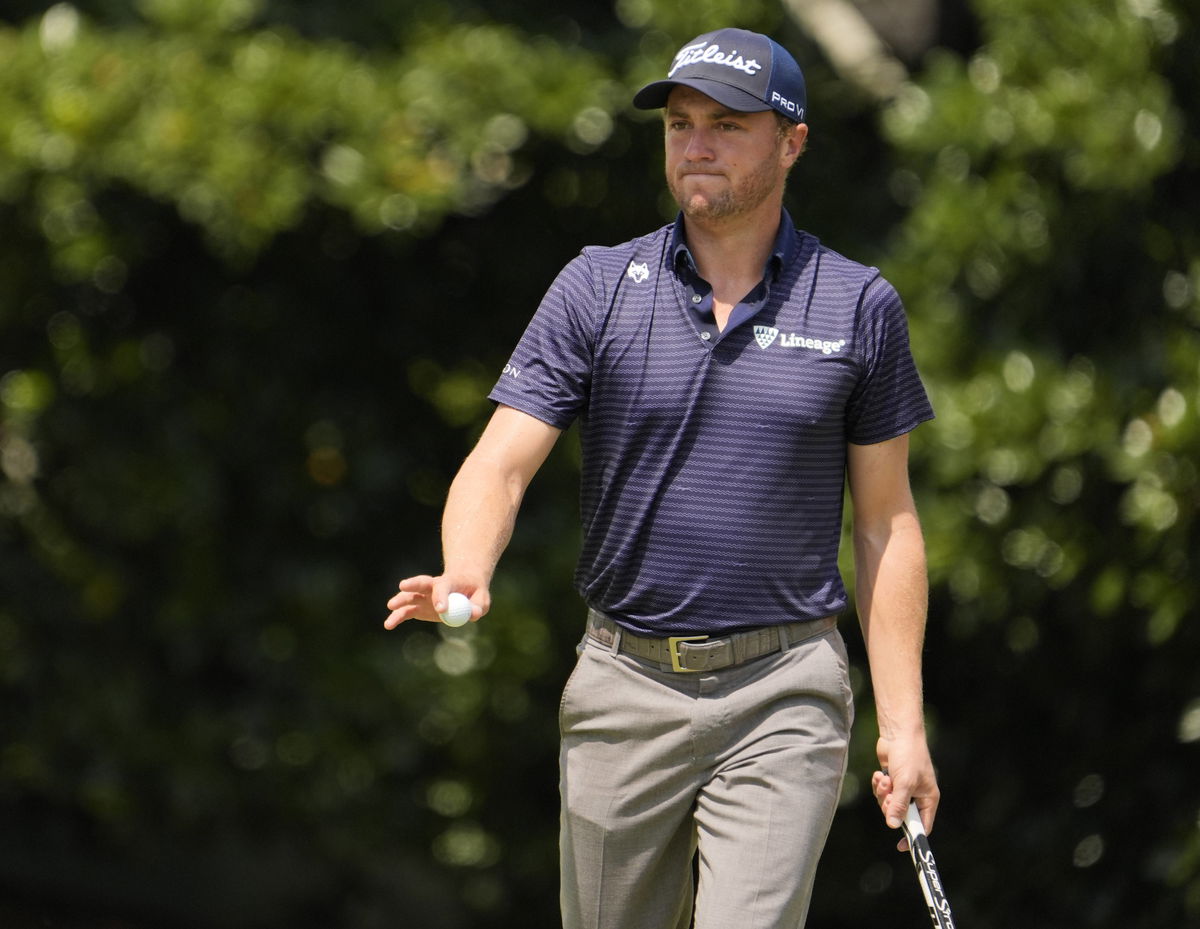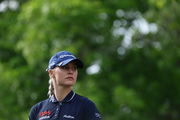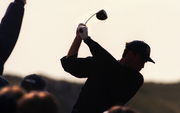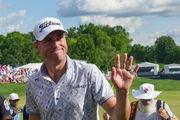
Imago
PGA, Golf Herren TOUR Championship – Second Round Aug 30, 2024 Atlanta, Georgia, USA Justin Thomas waves to the gallery after his putt on the second green during the second round of the TOUR Championship golf tournament. Atlanta Georgia USA, EDITORIAL USE ONLY PUBLICATIONxINxGERxSUIxAUTxONLY Copyright: xJohnxDavidxMercerx 20240804_jdm_sx1_065

Imago
PGA, Golf Herren TOUR Championship – Second Round Aug 30, 2024 Atlanta, Georgia, USA Justin Thomas waves to the gallery after his putt on the second green during the second round of the TOUR Championship golf tournament. Atlanta Georgia USA, EDITORIAL USE ONLY PUBLICATIONxINxGERxSUIxAUTxONLY Copyright: xJohnxDavidxMercerx 20240804_jdm_sx1_065
USGA’s Rule 6-7: The player must play “without undue delay and in accordance with pace-of-play guidelines.” A group is out of position when it completes play on a hole later than the maximum allowable time under those guidelines. If a group gets out of position due to a ruling or some other legitimate delay, the group is expected to regain its position within a reasonable time.
Watch What’s Trending Now!
On the opening day, reigning US Open champion, JJ Spaun was given a bad time warning after he took over the expected 50 seconds as the first player of his group on the 17th. In fact, the trio of Spaun, Xander Schauffele, and Jon Rahm got a slow play warning from the R&A rules official Charlie Maran for completing their round in about five and a half hours. The Open championship has become ground zero for all sorts of PGA Tour discussions this year. One of the repeated topics at the Royal Portrush, especially because almost all rounds are taking close to or over 5 hours each, has been slow play. But it’s not a new issue.
After his TGL debut in January, Justin Thomas, who has also spent a decade on the Player Advisory Council was thrilled how the league’s 40-second shot clock kept things moving smoothly. However, he assessed, “Pretty much a lot of the conversations end the same way; it’s like, what are we trying to accomplish here? Are rounds going to be 12 minutes faster? Are they going to be 20 minutes faster?” But he also highlighted “(The fans) like harder golf courses, they like watching us play difficult places but they want us to play faster, so those two don’t go together.” And with The Open facing the same issue, Matt Fitzpatrick has also agreed with JT.
ADVERTISEMENT
In his presser on Friday in the 153rd Open, a reporter asked the former US Open champ about the slow pace of play as a player with a reputation to be pretty fast. He honestly answered, “I do think it’s ridiculous; the pace of play has been a combination of the way the golf course is, reachable par-5s and all that normal stuff. But it starts with the players as well and starts with the rules officials. Obviously, we’d all like to be round in four and a half hours, but that’s the case, and it’s five and whatever it was today. But that is what it is, so just accept that and try and stay as focused as I can on my own game and play as best as I can.”
The reporter further asked Fitzpatrick how he would fix the problem “If I gave you a magic wand?” This time, the English golfer responded vaguely, “I think it’s just impossible to answer, isn’t it. There’s so many different parts to it. Like I said, this golf course is perfect for it because there’s reachable par-5s and drivable par-4 and whatnot, and other golf course have long walks to tees. It kind of spreads out a little bit. Yeah, I think it is a difficult one. But I think players probably speeding up a little bit probably will help the situation, but yeah.”
Now again, while he resonates with what Thomas said, it cannot be denied that the fans demand both tougher setups and quicker rounds. The math simply doesn’t work. And as for Royal Portrush, these are the reasons that have added to the increased time to complete each round:
ADVERTISEMENT
- Big fields: The Open has 156 players in its field, same as the US Open and US PGA Championship. However, the players don’t start simultaneously on the first and 10th tees like the American majors, adding to the ‘rushed’ feeling overall.
- Tough weather conditions: When it comes to Northern Ireland, this doesn’t need explanation. England’s Justin Rose simply stated about the wet and wild conditions, “It can happen sometimes. It got blustery as the day went on, so it was tricky – there were not many tap-in pars and go.” Many, including Phil Mickelson’s group, even had to face rain delays.
- Challenging course design: The whipping winds also made tee shots difficult with wayward driving and off-target shots. Then, golfers having to look for the balls in thick grasses only added to the time. In fact, only 31 players shot under par on day 1.
- Pin positions: The set-up of pins tucked away in the corners of the greens left golfers to make mistakes or take longer to size up to the long putts. Two-time European Tour winner Graeme Storm even disclosed on BBC Radio 5 Live, “I was speaking to a referee who said it would be a lot better if the pins were more accessible.”
- Log jams on shorter holes: On pinch points like the fifth, sixth, and seventh holes, faster golfers had to wait even 20 minutes to get their chance. The fifth is a drivable par-four but then follows par-three sixth and then a par-five seventh.
The sport’s most knowledgeable insiders acknowledge the problem. However, they provide no roadmap for the future. PAC members discuss the pace of play endlessly during meetings. Nevertheless, they admit these conversations lead nowhere productive. And that might have a reason why.
ADVERTISEMENT
Top Stories
Charley Hull Opens Up on Traumatic Divorce from Ex-Husband for the First Time Ever

LIV Golf to Cut Ties With Veteran Pro After His PGA Tour Return Intentions Became Public

‘Penalize Him’: PGA Tour Q-School Faces Heat as Slow Play Incident Goes Unaddressed

Lydia Ko Learns Hard Lesson After Trying to Copy Jason Day’s Short-Game Technique

Justin Thomas Undergoes Intense Physical ‘Rehab’ After Surgery Delayed His PGA Tour Return

PGA Tour’s Leadership Vacuum
Recent PGA Tour initiatives feel more like window dressing than solutions. Officials tested rangefinders at select events. They reduced field sizes for 2026. Additionally, they established a “Speed of Play Working Group” and committed to publishing statistics. Despite these efforts, the fundamental issue persists unchanged.
Tour players regularly exceed five hours despite optimal conditions. They have yardage books, caddies, and meticulously maintained courses. Both Thomas and Fitzpatrick understand this disconnect completely. JT serves as a PAC veteran, having discussed the pace of play all 10 years of his Tour career. Similarly, Fitzpatrick built his reputation as a fast player and vocal critic.
ADVERTISEMENT
Back in 2019, at the BMW PGA Championship, he called slow play “unfair” and “disruptive.” He’s consistently called out slow competitors: “If you don’t speed up, then you deserve to be penalized. It’s unfair.” Thomas questions whether meaningful improvement is even possible. Fitzpatrick admits the problem defies simple solutions. Their combined experience spans decades of professional golf. Still, they offer no concrete answers.
The irony deepened recently when Fitzpatrick took over two minutes to complete a single stroke during the Genesis Scottish Open. Fans timed him at 2 minutes and 22 seconds on the 17th hole. The same player who once called slow play “truly appalling” became the problem he criticized. This pattern reveals a troubling leadership void in professional golf.
Still, Thomas and Fitzpatrick recognize fan frustration with endless delays. Television broadcasts suffer when groups fall behind schedule. Ticket-holders grow restless watching players deliberate over routine shots. Yet their honest admissions reveal the harsh truth. Golf’s leadership simply doesn’t know how to fix what everyone agrees is broken. The most qualified voices have essentially given up.
ADVERTISEMENT
ADVERTISEMENT
ADVERTISEMENT
ADVERTISEMENT

